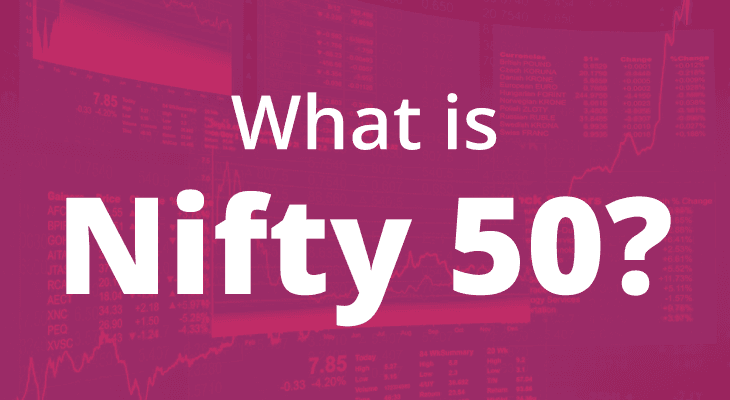
What is Nifty 50?
A stock market index is essentially a collection of stocks representing a section or the overall market. Financial experts use indices to track the performance of the market as a whole or a particular sector or industry. It also offers key insights into the current trend and investor sentiment.
Among the many indices currently in use, one of the most popular is Nifty50. Want to know the meaning of Nifty50 and what it takes for companies to be included in the index? Continue reading to find out.
What is Nifty 50?
The Nifty 50 is a broad-market index launched by the National Stock Exchange (NSE) on April 22, 1996. It comprises 50 of the top companies listed on the stock exchange across multiple sectors and industries. Most of the constituents of the Nifty50 are highly liquid blue chip companies with mature businesses, high market capitalisations and strong financials.
Since the index consists of 50 companies from all the major industries in India, it is often used by market experts to track the performance of the stock market as a whole and as a benchmark for mutual funds.
Things to Know About the Nifty50
Now that you’re aware of what the Nifty 50 index is, let’s look at a few things you need to know about the broad-market index.
It Is Governed Professionally
The index is professionally administered through a tiered governance system. The three-tier system comprises the NSE Indices Limited’s Board of Directors, an index advisory committee and an index maintenance sub-committee.
It Is Regularly Rebalanced
The Nifty50 index is reviewed regularly on a semi-annual basis, i.e. twice every year. The cut-off date for the review is the 31st of January and 31st of July. During the semi-annual review, the three governing bodies examine whether the current constituents of the index continue to meet the eligibility criteria required to feature in the Nifty50 index.
If any company doesn’t meet the necessary requirements, it is removed from the index. Furthermore, the governing bodies also examine the data of all of the companies listed in the NSE to determine if any company meets the eligibility criteria to be included in the index. The companies that meet the criteria are included in place of those removed from the index.
It Consists Of 14 Sectors
The Nifty50 index features companies from 14 different sectors, making it one of the most comprehensive broad-market indexes in India. The sectors that feature in the index and their respective weightage as of October 31, 2023, are as follows.
Sectors | Weightage (%) |
|---|---|
| Financial Services | 35.86% |
| Information Technology | 13.62% |
| Oil, Gas & Consumable Fuels | 11.37% |
| Fast Moving Consumer Goods | 9.49% |
| Automobile and Auto Components | 6.27% |
| Construction | 4.23% |
| Healthcare | 4.03% |
| Metals and Mining | 3.67% |
| Consumer Durables | 3.20% |
| Telecommunications | 2.76% |
| Power | 2.44% |
| Construction Materials | 1.99% |
| Services | 0.75% |
| Chemicals | 0.32% |
Eligibility Criteria for Nifty50 Index
As an investor, it is not enough to just know the meaning of Nifty50. Instead, you also need to know the criteria that companies need to satisfy to be eligible for inclusion into the index. Here’s a quick overview of the eligibility criteria for Nifty50.
The company must be registered and conduct business in India.
The company must be listed on the National Stock Exchange for a period of at least 6 months.
The stock must have a listing history of at least 1 month on the cut-off date.
The stock must be highly liquid and have an average impact cost of 0.50% or less for a basket size of Rs. 100 million during the previous 6 months from the cut-off date.
The stock must be actively traded in the derivatives (Futures and Options) segment.
What are the Top Companies in Nifty50 and their Weightage?
In addition to understanding what Nifty50 is, you should also be aware of the top constituents of the index and their weightage. This can help you make well-informed investment decisions. Here’s a table outlining the top 10 companies that feature in the broad-market index as of October 31, 2023.
Top 10 Companies | Weightage (%) |
|---|---|
| HDFC Bank Limited | 13.24% |
| Reliance Industries Limited | 9.25% |
| ICICI Bank Limited | 7.66% |
| Infosys Limited | 5.84% |
| ITC Limited | 4.53% |
| Larsen & Toubro Limited | 4.23% |
| Tata Consultancy Services Limited | 4.12% |
| Axis Bank Limited | 3.25% |
| Kotak Mahindra Bank Limited | 3.06% |
| Bharti Airtel Limited | 2.76% |
How is the Value of Nifty50 Calculated?
The value of the Nifty50 index fluctuates constantly due to various factors like the performance of its constituents, demand and supply, economic conditions and investor sentiments. But have you wondered how the value of the index is computed?
The three-member governance team behind the index uses a special method known as the weighted free-float market capitalisation method. Here’s an overview of the formula that they use.
Nifty50 Index Value = Current Market Value ÷ (Base Market Capital x 1,000)
The current market value represents the weighted total market capitalisation of all of the index’s constituents. The base market capital, on the other hand, represents the weighted total market capitalisation of all of the index’s constituents as of the base year of 1995. Finally, 1,000 represents the base value of the index.
What are Some Major Milestones of the NIFTY50 Index?
Over the years, the Nifty50 index has reached several unique milestones. Here’s a quick overview of some key landmark events the index has witnessed.
The value of the index touched the 20,000 mark for the first time on September 11, 2023.
The index took almost 10 years to move from the 5,000 mark to the 10,000 mark.
The index picked up pace and took only 6 years to go from the 10,000-point mark to the 20,000.
The index recorded the single biggest gain of 708.40 points (8.76%) on April 07, 2020.
In terms of percentage, the single biggest gain of Nifty50 came on March 18, 2009, when it rose by 17.74%.
Conclusion
With this, you must now know what the Nifty50 index is. It is one of the most popular indices used in the Indian stock market since it gives a fair overview of the overall market. This makes it an extremely valuable tool for investors, traders, mutual fund houses and even policymakers.

